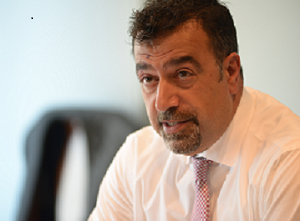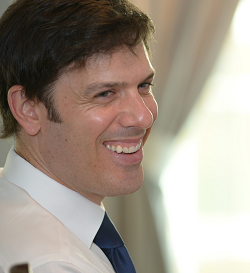Editor's note: In today's part 2 of our coverage of Morningstar's Canadian equity roundtable, the portfolio managers discuss their holdings in the recently reviving energy sector, with an emphasis on high-quality large-cap names.
Our panellists:
Hovig Moushian, senior vice-president, portfolio manager and head of the all-cap value team at Mackenzie Investments. His responsibilities include Mackenzie Canadian All Cap Dividend and Mackenzie Canadian All Cap Value.
Ryan Fitzgerald, senior portfolio manager and senior vice-president at Harbour Advisors, a separate portfolio-management group under the C.I. Investments Inc. umbrella. A value manager, Fitzgerald's responsibilities include CI Harbour, CI Harbour Corporate Class, CI Harbour Global Equity Corporate Class and CI Harbour Voyageur Corporate Class.
Michael O'Brien, managing director and head of the core Canadian equity team at TD Asset Management Inc. His mandates include that of lead manager of TD Canadian Equity and TD Balanced Income. O'Brien's investment style is GARP, growth at a reasonable price.
Convened and moderated by Morningstar columnist Sonita Horvitch, this week's three-part series began on Tuesday and concludes on Friday.
Q: Can you briefly discuss your style in managing your portfolios? We will then focus on the key sectors in the Canadian equity market. Let's start with energy.
Fitzgerald: We have about 40 names in Harbour Fund, which has foreign content of just over 30%. We are value investors, but not deep-value investors. We tackle energy in the most conservative way possible. There is an intense focus on asset quality, balance-sheet strength and management quality. If we want to increase or decrease our energy exposure, we tend to increase or decrease the weight of the identical basket of names.
 |
|
 |
|
| Hovig Moushian | |
 |
|
 |
|
 |
Currently, we have as much exposure to energy producers and the integrated energy companies as we would throughout the cycle. We own ![]() Suncor Energy Inc. (SU), we like Vermilion Energy Inc. (VET) and PrairieSky Royalty Ltd. (PSK). We have several U.S. names as well. We do not own any service companies. We have one pipeline stock,
Suncor Energy Inc. (SU), we like Vermilion Energy Inc. (VET) and PrairieSky Royalty Ltd. (PSK). We have several U.S. names as well. We do not own any service companies. We have one pipeline stock, ![]() TransCanada Corp. (TRP).
TransCanada Corp. (TRP).
Moushian: Mackenzie Canadian All Cap Dividend has 58 names and 15% in foreign content. We look for relative value. Our exposures across the capitalization spectrum vary depending on where we are in the market cycle. We are currently heavy on the large-cap side, as we are nearing the end of a bull market. Our positioning in various sectors stays fairly constant. What changes is where we take our risk concentration within a sector. When opportunities abound, as dictated by good valuations, we will take greater risk in riskier names in that sector. When opportunities are scarce, we will opt for less risky names.
In energy, our biggest name is ![]() Crescent Point Energy Corp. (CPG). Our second largest holding is
Crescent Point Energy Corp. (CPG). Our second largest holding is ![]() Peyto Exploration & Development Corp. (PEY), and we have a holding in
Peyto Exploration & Development Corp. (PEY), and we have a holding in ![]() Canadian Natural Resources Ltd. (CNQ). Valuation is a huge determinant. Crescent Point has been battered. Investor sentiment is negative on the name. There are some valid reasons, but we think that the negativity has been overdone.
Canadian Natural Resources Ltd. (CNQ). Valuation is a huge determinant. Crescent Point has been battered. Investor sentiment is negative on the name. There are some valid reasons, but we think that the negativity has been overdone.
O'Brien: TD Canadian Equity has about 50 names and a foreign content of about 10%. We tend to emphasize consistency and stability rather than absolute growth rates. We are enthusiastic about the energy sector. We have some core holdings like Suncor and Canadian Natural Resources. They have both reached maturity in terms of their asset base and are well positioned to generate free cash that can be paid out to shareholders, even in the current oil-price environment. A third name is ![]() Cenovus Energy Inc. (CVE). This has had more of a struggle. Its asset base is less mature and less diversified than that of Suncor and CNQ.
Cenovus Energy Inc. (CVE). This has had more of a struggle. Its asset base is less mature and less diversified than that of Suncor and CNQ.
I will add names around these core holdings. We have felt that the sentiment regarding this sector was overly negative. We have smaller positions in some intermediate producers, such as Whitecap Resources Inc. (WCP), ![]() ARC Resources Ltd. (ARX) and
ARC Resources Ltd. (ARX) and ![]() Tourmaline Oil Corp. (TOU). On the pipeline side, core holdings are TransCanada and
Tourmaline Oil Corp. (TOU). On the pipeline side, core holdings are TransCanada and ![]() Enbridge Inc. (ENB).
Enbridge Inc. (ENB).
Moushian: There are some reasonable valuations among the pipeline companies. I own TransCanada and Enbridge. I also have a substantial weight in ![]() Pembina Pipeline Corp. (PPL). I have no energy-services stocks.
Pembina Pipeline Corp. (PPL). I have no energy-services stocks.
| Enbridge Inc. | Pembina Pipeline Corp. | TransCanada Corp. | |
 |
|||
| Oct. 6 close | $51.81 | $42.67 | $61.75 |
 |
|||
| 52-week high/low | $59.18-$48.98 | $44.65-$37.25 | $65.24-$57.36 |
 |
|||
| Market cap | $85.1 billion | $21.6 billion | $54.0 billion |
 |
|||
| Total % return 1Y* | 4.7 | 10.9 | 4.2 |
 |
|||
| Total % return 3Y* | 3.5 | 0.8 | 6.3 |
 |
|||
| Total % return 5Y* | 8.5 | 13.0 | 9.8 |
 |
|||
 |
|||
| *As of Oct. 6, 2017 Source: Morningstar |
|||
Fitzgerald: These pipeline companies also have huge natural-gas businesses. There will still be spending on North American gas infrastructure and it is an interesting growth area.
Q: In the Canadian materials sector, can we focus on gold stocks, which are a big weight in this sector?
 |
|
 |
|
| Ryan Fitzgerald | |
 |
|
 |
|
 |
Moushian: Gold stocks act as an insurance policy in a portfolio. Some Canadian gold companies have high single-digit free-cash-flow yields. If management's capital discipline holds this time, there is decent value to be had among gold stocks. We own ![]() Goldcorp Inc. (G) and
Goldcorp Inc. (G) and ![]() Yamana Gold Inc. (YRI). The latter is higher risk and has a high leverage to a rise in bullion prices.
Yamana Gold Inc. (YRI). The latter is higher risk and has a high leverage to a rise in bullion prices.
Fitzgerald: We invest only in higher-quality gold companies that have positive free cash flow and manage their balance sheets appropriately. We have about a 4% weight in gold stocks in Harbour Fund. Our biggest gold-stock holding is Franco Nevada Corp. (FNV), closely followed by ![]() Agnico Eagle Mines Ltd. (AEM). Franco is not a gold-mining company. It collects a royalty from others that are. It has an excellent management team. The stock is generally expensive and we recently took some profits there.
Agnico Eagle Mines Ltd. (AEM). Franco is not a gold-mining company. It collects a royalty from others that are. It has an excellent management team. The stock is generally expensive and we recently took some profits there.
O'Brien: Gold is a good counter-balance to a portfolio. A caveat is that gold mines deplete quickly, so companies need to take this into account when implementing their capital discipline. TD Canadian Equity has about 4.5% in gold stocks. Similar to Ryan, we have holdings in Franco Nevada, which is the top of its class. Yes, the stock is expensive. We also have a holding in Agnico Eagle and a modest holding in Goldcorp. In the same way that we like to concentrate our holdings in energy in stocks like Suncor and CNQ, we like to concentrate our holdings in quality players like Franco Nevada and Agnico Eagle in the materials sector.
Q: Turning to financial services, a period of rising interest rates usually bodes well for the banks and insurers. Can we discuss this?
Moushian: Donald Trump's election as U.S. president in November 2016 was accompanied by a rise in U.S. interest rates. At the time, the Canadian insurance stocks moved significantly. This included the stocks of ![]() Sun Life Financial Inc. (SLF), Industrial Alliance Insurance and Financial Services Inc. (IAG) and
Sun Life Financial Inc. (SLF), Industrial Alliance Insurance and Financial Services Inc. (IAG) and ![]() Manulife Financial Corp. (MFC). Manulife's valuation, in particular, moved up sharply. The insurance stocks have treaded water since. Though Canadian interest rates have risen, this has been more at the short end of the yield curve. Valuations are still reasonably attractive among the insurers.
Manulife Financial Corp. (MFC). Manulife's valuation, in particular, moved up sharply. The insurance stocks have treaded water since. Though Canadian interest rates have risen, this has been more at the short end of the yield curve. Valuations are still reasonably attractive among the insurers.
O'Brien: In the context of a Canadian equity market that looks fairly richly priced, the banks and the insurers are both trading at or below their historic valuation levels.
 |
|
 |
|
| Michael O'Brien | |
 |
|
 |
|
 |
Fitzgerald: The linkage between interest rates and financial services is not as simple and strong as it is thought to be. Rising interest rates are good for financial institutions, provided the long end of the yield curve is steepening.
Q: Will rising Canadian short-term interest rates have an impact on Canadian dividend-paying stocks?
Moushian: The current dividend yield on the S&P/TSX Composite Index is around 2.8%, largely in line with the average of the last five years. Some 76% of the companies that comprise the Composite pay a dividend. These companies account for a 93% weighting in the benchmark. Investors need to distinguish between companies that have little or no growth in their dividends in combination with elevated valuations, and those companies that pay a reasonable dividend that they can grow, and this is combined with reasonable valuations. We do not expect interest rates to rise substantially.
Fitzgerald: The relationship between interest rates and dividends is again one of those linkages that are somewhat overblown. Canadian investors love their dividends.
Photos: Paul Lawrence Photography


















